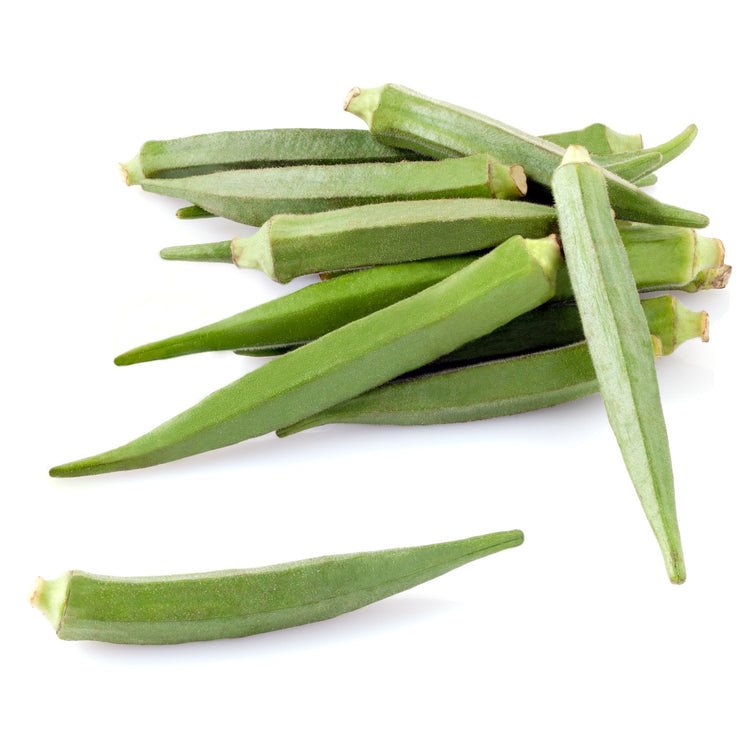Okra

Known as “ladies’ fingers,” okra is a bright green veggie known for its unique texture, flavor, and amazing health benefits. Okra is widely cultivated and beloved all over Africa, Asia, and the Americas and is indispensable in all sorts of cuisines. From soups and stews to health remedies, it is versatile and a keeper in your diet.
In this blog post, we will delve into the origins, nutrition, health benefits, culinary uses, and best practices for growing and storing okra.
Table of Contents
Introduction to Okra
Nutritional Value of Okra
Health Benefits of Okra
Culinary Uses of Okra
How to Grow Okra
Tips for Storing Okra
Conclusion
Introduction to Okra
The flowering plant of the mallow family is scientifically called Abelmoschus esculentus and commonly known as okra. it has its origins in tropical Africa, but its versatility has gained it a place around the globe as people have come to appreciate the culinary contributions of okra to many traditional recipes. Edible seed pods are the main draw, and they have a mild flavor and mucilaginous texture that make them perfect for thickening up soups and stews.
Nutritional Value of Okra
Okra is a highly nutritious food and an important part of a balanced diet. A raw cup of okra (around 100 grams) has:
• Calories: 33
• Dietary Fiber: 3.2 grams
• Vitamin C: 23% of the DV (Daily Value)
• Vitamin K: 44% of the daily suggested amount
Folate: Delivers 15% of the daily recommended value.
• Magnesium: 7% of daily value
Okra is also a rich source of antioxidants — polyphenols and flavonoids, in particular — which protect the body against oxidative stress.
Health Benefits of Okra
3.1. Supports Digestive Health
Okra is aim to combat constipation because of the high fiber content in it helps maintain bowel regularity. The mucilaginous nature also calms the digestive tract.
3.2. Regulates Blood Sugar Levels
It may stabilize blood sugar levels by slowing down sugar absorption in the gut. It’s especially helpful for those who are living with diabetes.”
3.3. Boosts Immune Function
Rich in vitamin C and other antioxidants, it boosts the immune system and guards the body against common illnesses.
3.4. Promotes Heart Health
Okra also contains soluble fiber that can reduce levels of cholesterol, and in turn decrease the risk of heart disease. Its antioxidant capability helps prevent cardiovascular injury as well.
3.5. Enhances Skin and Hair Health
Okra is also rich in vitamins and minerals that nourish the skin and hair, keeping both well hydrated and improving their texture.
Culinary Uses of Okra
It is an ingredient in its many forms. Here are some common culinary applications:
4.1. Soups and Stews
It is an important component of their classic dishes, such as gumbo and African soups, that use its mucilaginous quality to thicken the broth.
4.2. Fried Okra
Fried okra coated in cornmeal and spices makes for a tasty snack or side with its crispy outside and tender inside.
4.3. Pickled Okra
Pickle pickling okra prolongs its lifespan and delivers an intensively-sour, crunchy snack that complements sandwiches and charcuterie plates.
4.4. Stir-Fries
Sliced okra can be stir-fried with other vegetables, spices and proteins for a quick, healthy meal.
4.5. Smoothies and Juices
Mixing raw okra with fruits and vegetables yields a very nutrient-dense drink that is high in fiber and antioxidants.
How to Grow Okra
Okra grows fairly easily, preferring warm climates with lots of sunshine.
5.1. Soil Requirements
Okra flourishes in nutrient-rich, well-drained soil with a pH range of 6.0 to 6.8.
5.2. Planting Tips
• Direct sow seeds in the soil after the last frost.
• Seed space of 12 to 18 inches for good growth.
5.3. Watering and Maintenance
• Water the plants consistently, especially in dry periods.
• Weed and mulch to keep moisture in the soil.
5.4. Harvesting
For the best texture and flavor, harvest okra pods when they are 3 to 4 inches long. Don’t leave them on the plant too long; they can become tough and fibrous.
Tips for Storing Okra
Okra stays crisp and tasty if you store it right.
6.1. Refrigeration
Fresh okra can be stored in the refrigerator, in a perforated plastic bag, for three days.
6.2. Freezing
For long-term storage, blanch okra pods in simmering water for a few minutes and freeze in airtight containers.
6.3. Drying
You can dry okra pods in the sun or a dehydrator for use in soups and stews all year long.
Conclusion
It is a nutritious and versatile plant that deserves a spot in every kitchen. It is a super food with numerous health benefits and culinary applications. Whether you’re growing it yourself in your garden or purchasing it fresh at your local market, you might be surprised to discover that okra can add new depth to your meals and improve your health.
Try okra today and Discover Health and Flavor without limits. click here to know more
